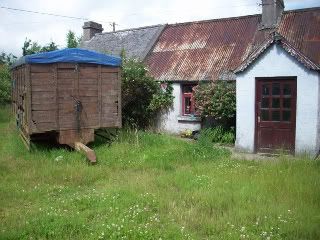

My great-great-great-grandparents lived in it.
More on that later.
I’ve been back from Ireland a few weeks, but I’ve only gotten around to typing it up until now. So there.
My dad and I planned to spend ten days in Ireland. Our mission? Find evidence of my great-grandmother. One can get dual citizenship in Ireland if you have one grandparent that was born in the country, as my dad has.
Now one might ask, how come we never looked for this until now? Well, people have. My dad and stepmom went to Ireland three years ago and came up with nothing. His uncle and daughter went many years ago and found nothing. How were we going to find evidence on my Irish ancestors this year when the last relative to have known them, my grandmother, died over a year ago?
Here’s what we knew before my grandmother died. I decided to only include their first names. Just assume they’re all very very Irish surnames, because they are. The first names are too.
My Irish great-grandmother (Mary) was one of four children. They were from County Carlow. Three came to America (the ones that came with her were Margaret and Patrick), and one (Thomas) stayed behind. Mary and Margaret lived in Manhattan, Patrick in White Plains. Mary later moved to Queens, where she died in 1937. Margaret died in 1941. They’re buried in the same grave. The headstone says Margaret was born in 1868, and Mary in 1878. But we had reason to believe Mary was lying about her age.
Here’s what I found after my grandmother died, after I found a desk full of all her letters, which were meticulously organized by recipient:
I found an envelope labeled “Mary Kelly and Ireland.” There was one letter from 1940 or so from Mary Kelly, telling my grandmother that she’d given her and my grandfather’s address to a distant cousin in Ireland. The other letters, written during WWII, seemed to be to Mary Kelly from that cousin, and even though they were vague, they seemed to imply that Thomas, the uncle that stayed behind, had had children. One letter mentioned Frank and Pat, another Frank and Luke. Another mentioned a daughter that was a nun. These letters were from a town called Pollerton Little, in County Carlow.
Written on that envelope was a kind of family tree in my grandmother’s handwriting. It began with “Francis and Elizabeth (grandparents),” followed by “Children: Thomas and Margaret (twins), Patrick, Mary. Thomas married twice. Patrick married Margaret.” (No, Patrick did not marry his sister, I’m not including last names, remember?) The main thing about finding this envelope was that it contradicted the names of the parents listed on Mary’s death certificate. Those were listed as Thomas and Mary.
Here’s what my dad found a few months before we left:
There’s a website that lists what’s on gravestones in cemeteries in Ireland. It’s done by volunteer submission. And someone had submitted the headstones in a cemetery in Bennekerry, County Carlow, which had several of them with the surname we were looking for. One was erected by a Patrick “of White Plains, New York,” but all the other names were wrong. Another was for a Francis and Elizabeth, erected by Thomas of Rutland, and Thomas was buried there, along with his two wives. There was also a child of Thomas’s there, died age 31 in 1930, and also a baby buried in 1972. This seemed more like it, even though we had no idea where the baby came from. Rutland, Bennekerry, and Pollerton Little are all within two miles of each other, too.
Here’s what my dad and I found out within the week before we left:
My aunt had given my dad a book a few Christmases ago about finding Irish ancestry, and I read part of it. It told me that in Ireland, births were registered in parishes, and there were church parishes and civil parishes. Civil registration wasn’t required in Ireland until 1864. (Good, just in time for my ancestors to be born!) I also looked up all the places in Ireland that I could search about ancestry. I also found the website of the parish of Bennekerry, which said that before 1976, I need to be looking in the Tinryland parish. We didn’t even know if it was our relatives in that grave, but it was good to know. Also, the book told me that most of the church records back in the day were in Latin, including Latinizing most of the names. So since I was looking for a Mary, I had to search for Maria. And even then, the names might be different from what you thought they were, spelling or otherwise.
I also checked my grandmother’s birthday poster before we left. It had hung for decades on her basement door, where I stared at it from her kitchen, learning all the zodiac signs, birth stones, birth flowers, and most importantly, the birthdates of all my immediate relatives. Mary’s and Margaret’s birthdays were on it, and the more information you know, the better.
According to the book, just knowing the county your ancestors were from was a great start. We had names, approximate birthdates, and possibly the towns they lived in. And even then, we expected to find nothing.
We didn’t know how wrong we were.
No comments:
Post a Comment